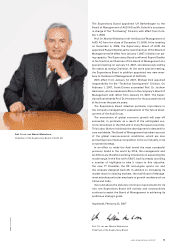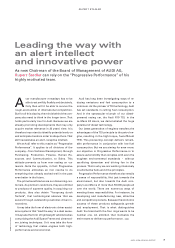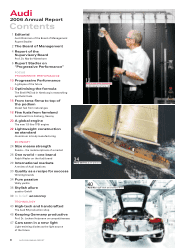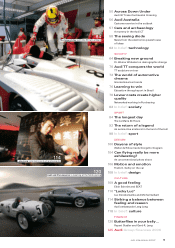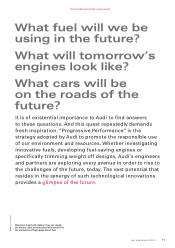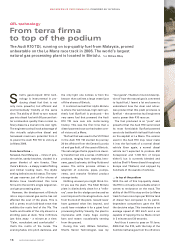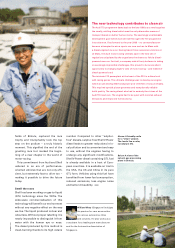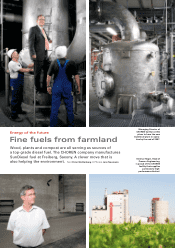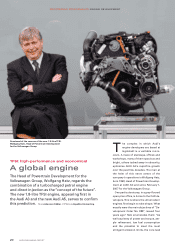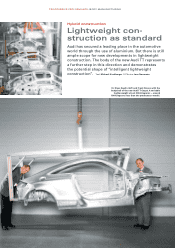Audi 2006 Annual Report Download - page 17
Download and view the complete annual report
Please find page 17 of the 2006 Audi annual report below. You can navigate through the pages in the report by either clicking on the pages listed below, or by using the keyword search tool below to find specific information within the annual report.
Markus Gärtner, 46, has been re-
porting from Vancouver as an inde-
pendent correspondent since 2004.
He was previously Bavaria reporter
for the Deutschlandfunk radio station,
Frankfurt correspondent of the ARD television
station, Southeast Asia correspondent for
Die Welt and Handelsblatt’s man in China for
six years.
Top: Dr. Warnecke regards
the production of diesel from
natural gas or biomass as
an intermediate step along
the road to the hydrogen age.
Bottom: For well over two
years now, drivers have been
enjoying the benefits of Shell
V-Power, the fuel produced
by the gas-to-liquid (GTL)
process, for example at the
World Economic Forum 2007
in Davos.
PROGRESSIVE PERFORMANCE: POWERED BY SYNFUEL
PHOTO (BOTTOM): AUDI
15AUDI 2006 ANNUAL REPORT
Alternative: bio-ethanol
The Canadian biotech company Iogen, based
in Ottawa, operates the only demonstration
plant in the world that produces cellulosic
ethanol from agricultural waste, such as
wheat stalks, maize cobs and straw. Enzymes
break down the residue from harvesting into
a sugary mass from which alcohol is distilled.
As it comprises waste products, the environ-
mental balance is virtually neutral. The yield
per hectare of land is moreover much higher
than for conventional ethanol. 340 litres of
ethanol are obtained from every tonne of
cellulose. The cost is currently around 36 US
cents per litre. Iogen is planning to build the
world’s first large-scale ethanol production
plant in 2007, probably in the US state of
Idaho. The US government is calling for cellu-
losic ethanol to be available at filling stations
at competitive prices within six years. It is
already being mixed with conventional petrol.
Expectations of the Iogen process are so high
that the investment bank Goldman Sachs
invested in the company in May 2006. At the
start of 2006 the Volkswagen Group agreed a
partnership with Iogen to pioneer the tech-
nology for cellulosic ethanol and examine the
scope for building an industrial-scale plant
in Germany. The head of the company is
engineer Brian Foody. Foody has developed
the enzyme manufacturer into one of the
leading players in the highly promising
market for biofuels.
by the end of the decade. It will be
around ten times the size of the
Malaysian plant, turning out 140,000
barrels per day. The International Energy
Agency (IEA) predicts daily production
of GTL fuel to reach 2.4 million barrels
by 2030. To place this in its context,
consumption is currently running at
around 90 million barrels of mineral oil
per day.
“It is not yet clear how many plants
there will be in the next ten years and
how available they will be,” admits
Warnecke. “By 2015, GTL will account
for a mere three or four percent of the
entire amount of fuel refined,” declares
Warnecke, an engine designer by back-
ground, confirming the IEA forecast.
That is why other alternative fuel sources
also need to be tapped, such as second-
generation biofuels (biomass-to-liquid
BTL) which, unlike first-generation bio-
fuels – where only the oily fruit is used –
use the entire plant or even green waste.
BTL fuels have the advantage that
their carbon dioxide balance is virtually
neutral. They can reduce CO2emissions
by over 90 percent compared with fuel
produced from mineral oil.
This is why Shell has invested in the
biofuel manufacturers CHOREN and
Iogen. “We want to provide assistance
of both a financial and technological
nature in promoting methods such as
those being pioneered by CHOREN and
Iogen, and we want to use these fuels.
Iogen is the leading player for petrol
substitutes, and CHOREN for diesel sub-
stitutes,” explains Wolfgang Warnecke.
GTL as an interim solution
GTL technology is of course being
pursued as a top priority. According to
Warnecke, the synthetic diesel is eco-
nomical to produce even at a crude oil
price of 25 US dollars a barrel. GTL is
nevertheless unable to keep pace with
conventional fuels in price terms. But it
does have a huge strategic advantage:
according to current estimates, the
world’s gas reserves will last 70 years –
30 years more than our crude oil re-
serves. Sufficient time, therefore, to
use biofuels as a wise interim solution
until the hydrogen age has properly
dawned.
“Hydrogen will definitely arrive, but
not to any substantial degree over the
next 20–25 years,” predicts Warnecke.
“So we will need an interim solution to
tide us over when making the transition
from carbon to hydrogen: synthetic
fuels which can increasingly be added
to present-day fuels.”
The breakthrough will depend on
a variety of factors
Superior availability and the much low-
er emissions alone will, however, not
suffice to help fuels such as GTL diesel
make a breakthrough as long as they are
unable to compete in price terms. In
Germany, around 70 percent of diesel
fuel is used by trucks and buses which,
Warnecke warns, are “extremely cost-
sensitive”.
The EU is aiming to boost biofuels
from a current two percent to six per-
cent of entire fuel consumption by 2010.
But the legislative body has not yet tak-
en account of all the benefits of modern
biofuels in calculating the tax incen-
tives: “The EU Commission – which lays
down the standards – really needs to
take account of how the fuel is pro-
duced as well. Focusing solely on what
comes out of the exhaust pipe is not
enough. That’s why the German govern-
ment is now providing tax incentives
for fuel obtained from sustainable raw
materials,” explains Warnecke.
Shell’s senior fuel developer is allud-
ing here to the complex processes that
Shell is developing together with its
partners Iogen and CHOREN. Consider-
able investment will still be needed be-
fore the first plants are able to go into
production on a large scale.


